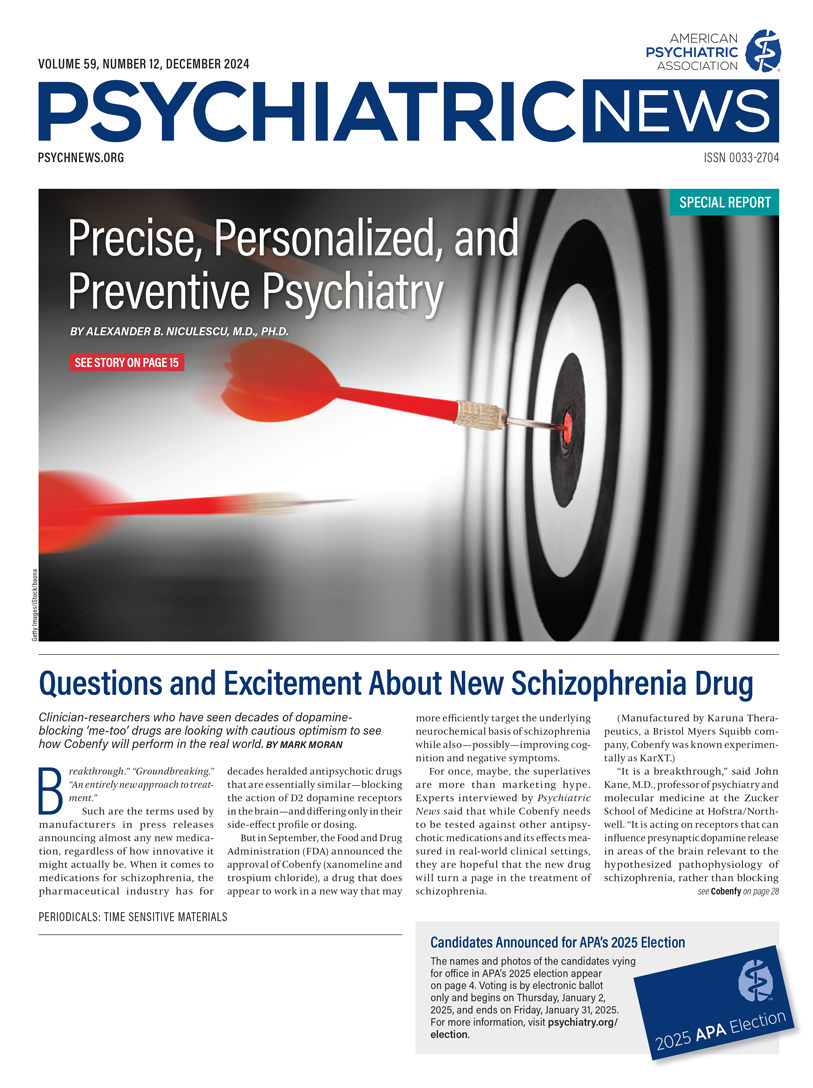“Breakthrough.” “Groundbreaking.” “An entirely new approach to treatment.”
Such are the terms used by manufacturers in press releases announcing almost any new medication, regardless of how innovative it might actually be. When it comes to medications for schizophrenia, the pharmaceutical industry has for decades heralded antipsychotic drugs that are essentially similar—blocking the action of D2 dopamine receptors in the brain—and differing only in their side-effect profile or dosing.
But in September, the Food and Drug Administration (FDA)
announced the approval of Cobenfy (xanomeline and trospium chloride), a drug that does appear to work in a new way that may more efficiently target the underlying neurochemical basis of schizophrenia while also—possibly—improving cognition and negative symptoms.
For once, maybe, the superlatives are more than marketing hype. Experts interviewed by Psychiatric News said that while Cobenfy needs to be tested against other antipsychotic medications and its effects measured in real-world clinical settings, they are hopeful that the new drug will turn a page in the treatment of schizophrenia.
(Manufactured by Karuna Therapeutics, a Bristol Myers Squibb company, Cobenfy was known experimentally as KarXT.)
“It is a breakthrough,” said John Kane, M.D., professor of psychiatry and molecular medicine at the Zucker School of Medicine at Hofstra/Northwell. “It is acting on receptors that can influence presynaptic dopamine release in areas of the brain relevant to the hypothesized pathophysiology of schizophrenia, rather than blocking postsynaptic receptors in multiple brain regions.”
Drug Acts on Muscarinic Receptors
For nearly 70 years, multiple “me-too” drugs—in keeping with the observation that schizophrenia is a disorder of excessive dopamine release—have blocked post-synaptic D2 receptors located throughout the brain. But most of those receptors are in areas unrelated to the symptoms of schizophrenia, resulting in all manner of side effects, including extrapyramidal symptoms, tardive dyskinesia, prolactin elevation, and weight gain.
It is the unique feature of Cobenfy to instead target muscarinic acetylcholine receptors (specifically M1 and M4 receptors) that regulate presynaptic synthesis of dopamine in the ventral tegmental area of the brain that is more central to the cognitive and behavioral symptoms of schizophrenia—turning off the spigot, as it were. “The notion is that this medicine is acting in a way that is closer to the underlying putative pathophysiology of the illness—excessive presynaptic dopamine release,” Kane said. “It is decreasing that release rather than blocking the post-synaptic receptor.”
Henry Nasrallah, M.D., professor of psychiatry, neurology, and neuroscience at the University of Cincinnati, added: “For 70 years we have been blocking dopamine receptors to treat schizophrenia, but it is still being excessively synthesized in the presynaptic neurons. This is a much smarter way to reduce dopamine activity in regions of the brain related to psychosis.”
Nasrallah added that the degree of symptom improvement in pre-approval treatment trials for KarXT is comparable to those seen for clozapine, the antipsychotic with the highest efficacy according to meta-analyses of all clinical trials, and the only antipsychotic approved by the FDA for treatment-resistant schizophrenia.
Other experts who spoke with Psychiatric News echoed Kane’s and Nasrallah’s careful optimism. “If you take all the problems associated with existing antipsychotics, there are very plausible advantages to a drug that doesn’t act on dopamine receptors,” said Stephen Marder, M.D., professor of psychiatry at UCLA.
“At this point, there are a lot of questions still,” he said. “The medication has only been compared to placebo, and we don’t know how it will do compared to other antipsychotics. Medications sometimes look better in clinical trials than they do in the real world. Will it be as effective or more effective than clozapine?”
While Cobenfy avoids many of the side effects associated with the D2 targeting me-too drugs, it has its own—especially gastrointestinal (GI) side effects. Among the most common identified in treatment trials are nausea, indigestion, constipation, vomiting, abdominal pain, diarrhea, and gastroesophageal reflux disease.
“The drug will have a burden of GI effects, and we don’t know how severe that burden will be,” Marder said. “It appears that patients develop a tolerance to the nausea, but we will have to see how that manifests itself in the real world. It’s very exciting, even if there many things we don’t yet know.”
Robert Cotes, M.D., professor of psychiatry at Emory University and director of the clinical and research program for psychosis at Grady Health System, is a champion of clozapine. But he said that, while it can be transformative for patients with treatment-resistant schizophrenia, it does not work for everyone, underscoring an urgent need for alternatives.
“KarXT’s recent approval offers hope to patients, families, and clinicians, yet its role in treatment resistance—whether as an add-on to clozapine or an alternative when clozapine isn’t feasible—remains completely unknown,” Cotes told Psychiatric News. He added that current studies are examining KarXT’s effectiveness with other antipsychotics, “though none to my knowledge have yet combined it with clozapine.”
Cotes also pointed out that constipation was reported by 13% to 27% of patients in KarXT’s two short-term Phase III trials. That indicates “concerns about combining it with clozapine due to potential risks of worsening gastrointestinal hypomotility,” he said. “Overall, there are many unanswered questions, and we need further research to understand KarXT’s role in treatment-resistant schizophrenia.”
Cognitive Deficits, Negative Symptoms
That the muscarinic receptors M1 and M4 regulate pre-synaptic dopamine synthesis was a fortuitous finding, because those receptors were investigated for their influence first on cognitive deficits and later on negative symptoms—both of which are stubborn features of schizophrenia untouched by existing therapies.
Philip Harvey, Ph.D., professor of psychiatry and behavioral sciences and vice chair for research in the department of psychiatry at the University of Miami Miller School of Medicine, noted that Eli Lilly studied xanomeline (one of the two chemical agents comprising Cobenfy) as a treatment for Alzheimer’s in the 1990s. “They were targeting the M1 receptor, which is seen as the primary cognitive target in the muscarinic system,” Harvey said. “But M4 agonism was also a part of the drug’s effect, and that is where the antipsychotic efficacy most likely comes from.”
In an October 2024 review
article in
Frontiers in Psychiatry, Harvey and William Horan, Ph.D., executive director of clinical development at Bristol Myers, elucidated the effects of M1 and M4 agonists on cognition and negative symptoms and outlined the history of drug development targeting muscarinic receptors.
“Based on the unexpected finding that xanomeline improved psychotic-like symptoms, a small proof-of-concept study subsequently evaluated acute schizophrenia among inpatient participants assigned to xanomeline or placebo,” the authors wrote. “Those assigned to xanomeline demonstrated significant improvements in cognitive symptoms (list learning, story recall, and delayed memory) as well as positive and negative symptoms.”
But development of xanomeline was discontinued because of significant levels of cholinergic adverse events—namely nausea, vomiting, diarrhea, excessive sweating, and salivary hypersecretion. As Harvey and Horan noted, this led to the development of KarXT—“the combined formulation of two drugs, xanomeline and trospium chloride, that was designed to mitigate the peripheral muscarinic side effects observed with xanomeline.”
A
paper published in September 2024 in
Schizophrenia Research sponsored by Bristol Myers (with Marder as a co-author) looked at pooled data from three trials of KarXT on 640 patients with schizophrenia, and a subset of 64 with more severe negative symptoms (such as blunted affect, emotional withdrawal, and active social avoidance). Patients in the full sample receiving KarXT had significantly better scores on the
PANSS Marder Negative Factor Scores than those receiving placebo. Among those in the negative symptom subgroup, the difference was even greater—and remained significant after accounting for changes in positive symptoms, depression/anxiety, disorganization, and hostility.
“There was no correlation between antipsychotic efficacy and cognitive improvements across all three of the acute treatment trials, no overlap between those two effects,” Harvey told Psychiatric News. “If you are treating psychotic symptoms, you can’t always tell if you are improving cognition because you are also improving psychosis—but here the changes in cognition and changes in psychosis were not correlated. It’s as if you are taking two drugs.”
In a paper to be published in AJP in March 2025, Harvey, Horan, and colleagues found similar results—and the same independent finding for improvement in cognition—looking at data pooled from two five-week inpatient trials of KarXT monotherapy in 357 people with acute schizophrenia and a subgroup of 71 patients with cognitive impairment.
Not the Same Old Same Old
Clinician-researchers who have seen decades of the same old same old are looking with optimism to see how Cobenfy will perform in the real world. “This is an extremely promising drug,” Marder said, “and I would consider it as an alternative for people who aren’t responding to a current medication, and hopefully for patients who experience decreased motivation and lassitude.”
Kane added: “It will be interesting to see how patients in the early phase of a schizophrenia illness respond, as studies to date have involved more chronically ill subjects who have already been treated for years with traditional medications that might alter CNS receptors in ways that are not necessarily desirable.”
(Kane, Marder, Nasrallah, and Harvey have had consulting relationships with Karuna/Bristol Myers, and Cotes has received research funding from Karuna through Emory University. None of these experts has equity interest in these companies.) ■




